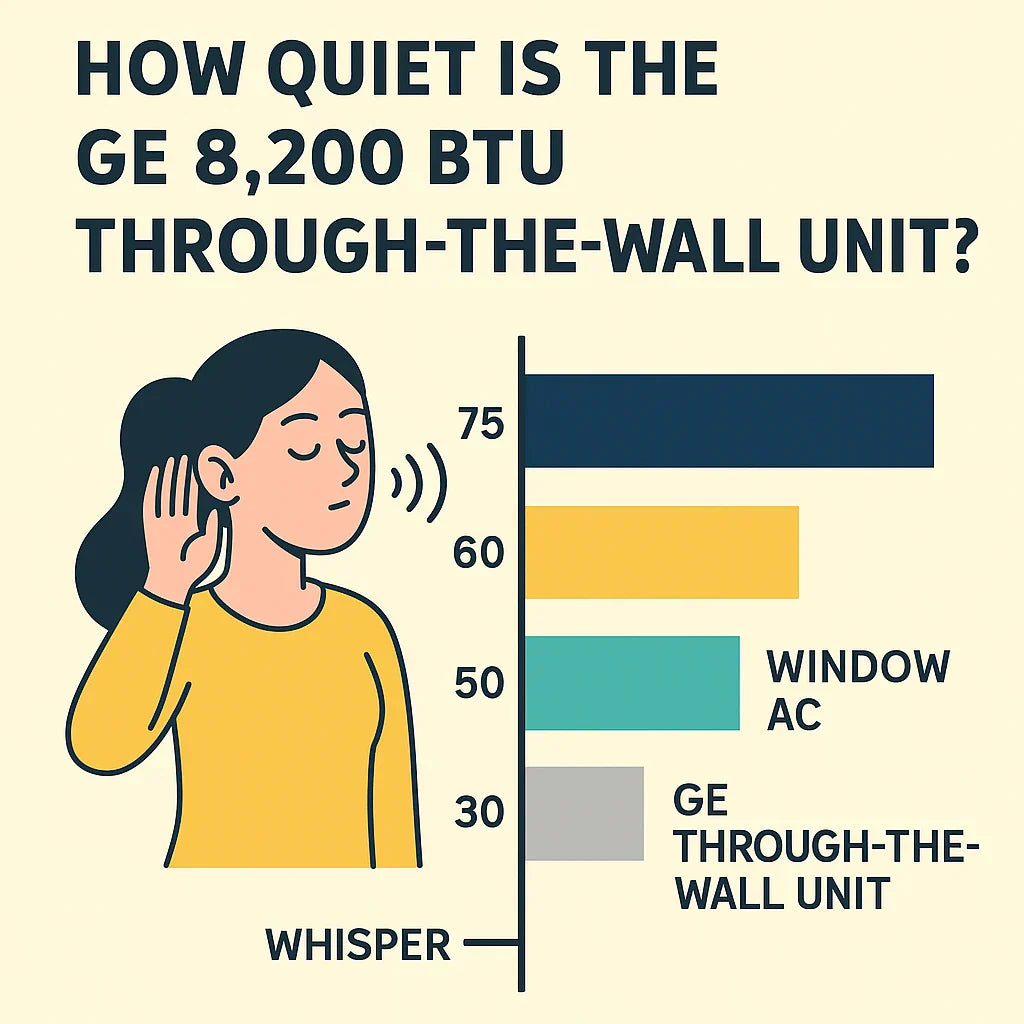How quiet is the GE 8,200 BTU wall AC/heat pump? Savvy Mavi breaks down decibel ratings, real-world comfort, comparisons to window units, and noise-reducing tips.
🌟 Why Noise Matters Just as Much as Cooling
When people shop for an AC, they focus on BTUs, efficiency, and price—but noise often becomes the dealbreaker.
Think about it:
-
A unit that cools well but buzzes loudly at night? Miserable.
-
A heat pump that heats your office but rattles during Zoom calls? Distracting.
That’s why noise ratings matter just as much as cooling power. Comfort isn’t just about temperature—it’s also about sound levels that let you sleep, work, and relax.
So, how does the GE 8,200 BTU Through-the-Wall AC with Heat Pump measure up? Let’s break it down.
📊 Understanding Decibel Ratings
Noise is measured in decibels (dB)—but what does that actually mean for your room?
Here’s a quick chart based on EPA noise standards and WHO guidelines:
| Sound | Decibels (dB) |
|---|---|
| Whisper | 30 dB |
| Quiet library | 35–40 dB |
| Normal conversation | 60 dB |
| Dishwasher | 55–65 dB |
| Window AC | 55–70 dB |
| GE 8,200 BTU wall unit | ~45–50 dB |
👉 In plain terms: the GE wall unit sounds more like a quiet fan than a dishwasher or window AC.
🔇 GE 8,200 BTU Noise Performance
The GE 8,200 BTU wall AC/heat pump is designed with noise control in mind.
-
Low setting: ~45 dB (equivalent to a quiet library).
-
High setting: ~50 dB (like soft background conversation).
For comparison:
-
Many window ACs run 55–70 dB, which can feel loud in small rooms.
-
Central HVAC systems usually hover around 40–45 dB, but they require ductwork.
💡 Savvy Takeaway: The GE 8,200 BTU wall unit lands in the “comfortably quiet” zone—great for bedrooms and home offices.
🪟 Through-the-Wall vs. Window AC: Noise Differences
Here’s where the design makes all the difference.
Window ACs
-
Rest in a window frame, often loose-fitting.
-
Vibrate against glass and thin panels.
-
Allow outside noise to leak in.
Through-the-Wall Units
-
Installed in a solid wall sleeve.
-
Sleeve insulation absorbs vibration.
-
Sealed edges keep out outdoor noise.
According to Consumer Reports, through-the-wall units consistently rate quieter than window ACs of similar size.
💡 Factors That Affect Noise Levels
Even the quietest AC can get noisy if certain factors are off.
🛠️ Installation quality
-
Loose sleeves = rattling.
-
Improper slope = water gurgling.
-
Poor sealing = vibration noise.
🧼 Maintenance
-
Dust on fan blades creates imbalance.
-
Dirty coils force fan to run harder.
-
Clogged drains cause bubbling sounds.
⚙️ Mode & Fan Speed
-
Higher speeds = more airflow noise.
-
Heat pump mode is usually a little quieter than cooling mode.
Energy.gov warns that neglected units often sound louder as efficiency drops.
🛠️ Savvy’s Tips to Minimize Noise
Want your GE 8,200 BTU unit to stay whisper-quiet? Follow these steps:
-
Level installation: Use a bubble level when installing in the wall sleeve.
-
Seal edges: Apply weatherproof caulk to prevent vibrations.
-
Add insulation: Foam strips around the sleeve reduce rattles.
-
Clean seasonally: Dust fan blades and coils.
-
Run on low at night: High fan speeds are great for quick cooling, but low is quieter for sleep.
According to Energy Star’s AC guide, proper installation and sealing reduce both noise and energy loss.
🌙 Comfort Beyond Decibels
Noise levels are just one piece of the comfort puzzle.
The GE 8,200 BTU unit also:
-
Cycles smoothly: No harsh “on/off jolts” like older ACs.
-
Provides steady airflow: Prevents hot/cold swings that disturb rest.
-
Offers dual use: Heat pump mode keeps your room warm without the roar of a space heater fan.
This balance of quiet + consistent comfort makes it perfect for:
-
Bedrooms → Sleep-friendly.
-
Home offices → Call-friendly.
-
Studios → White-noise effect without distraction.
👂 Real-World Comparisons
To put it in perspective:
-
GE 8,200 BTU wall unit: Like a quiet fan (background white noise).
-
Window AC: Noticeable humming and rattling, especially in older models.
-
Portable AC: Often 60–70 dB—like a vacuum cleaner in the corner.
-
Central HVAC: Quieter overall, but not an option for apartments or small homes.
👉 If you want a balance of quiet performance and efficiency, wall units beat window and portable ACs.
🧮 Case Studies: Noise in Everyday Life
Case 1: Small Bedroom (200 sq. ft.)
-
Owner upgraded from a 6,000 BTU window AC (60 dB).
-
New GE wall unit: 45–48 dB.
-
Reported better sleep and no rattling windows.
Case 2: Home Office (300 sq. ft.)
-
Used portable AC (65 dB).
-
Switched to GE 8,200 BTU wall unit.
-
Could finally take video calls without shouting.
Case 3: Studio Apartment (350 sq. ft.)
-
GE unit doubles as heat pump in winter.
-
Noise levels stay consistent year-round.
-
Acts as soft white noise, replacing the need for a separate fan.
✅ Savvy’s Final Word
So, how quiet is the GE 8,200 BTU through-the-wall unit?
👉 At 45–50 dB, it’s quiet enough for bedrooms, home offices, and small living spaces.
Compared to window ACs, it’s:
-
Quieter.
-
More stable (no rattling).
-
Better sealed (keeps outside noise out).
If noise is a top concern for your next AC, the GE 8,200 BTU wall unit isn’t just a good choice—it’s the smart one.
Because comfort isn’t just about the temperature you feel—it’s also about the peace you hear (or don’t hear).
In the next topic we will know more about: Wall Sleeves, Grilles & Accessories: What You Need for Your GE 8,200 BTU Install







